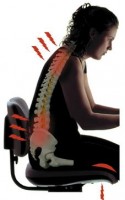“Dear Lord in heaven! Exactly how heavy WAS that piece of paper?!?” 
Now you’ve done it. Although, you’re not exactly sure what it is you’ve done, or how you managed to do it! You simply bent down to eradicate a seemingly innocuous scrap of paper from the floor. As you began to stand back up, WHAM! A sharp pain in your hip or low back alerts you that the possibility of standing up straight again isn’t going to be as easy as you had anticipated. You spend a brief moment contemplating that sharing a room with Quasi Moto in a bell tower in France might not be a bad gig before you brave forcing yourself upright through the pain. Although you’re now standing straight (which is debatable, but at least no one is asking you about your hump), you’re still in pain. What happened?
The Problem:
Does this scenario sound familiar? When we think of significant injury that can sideline us for days or weeks, we usually think about it resulting from some form of aggressive trauma – a car accident, falling down stairs, banging a leg into an end table, the list goes on. The thought that a significant injury could result from a seemingly benign act such as bending over and standing back up again borders on ludicrous, and yet how many times have you heard a story like this?
But what causes it? The answer might surprise you. The answer? Scar tissue.
“SCAR TISSUE?! Are you out of your mind? I’ve never been injured or operated on there. How on earth can I have scar tissue in an area I’ve never injured?”
Well, brace yourself. Believe it or not, yes, you can develop scar tissue WITHOUT the help of a scalpel or unfortunate happenstance. First, we have to look at the cycle of injury and its instigators or aggravators. There are actually three ways in which we injure ourselves:
- Acute injury
- Repetitive injury
- Constant pressure or tension
 Notice how acute injury begins on the cycle with a tear or a crush. This would be something invasive enough to break the skin, or a blunt trauma blow to the body. This acute injury is followed by inflammation, in which the now-damaged area swells. In order to heal, the body repairs the area of trauma with adhesions/fibrosis (scar tissue). This new repair area isn’t as strong or as flexible as it was prior to the injury, and you may notice that, although the area has healed, it is weak & tight. Because of this weakness/tightness, muscles adjacent to the injured area work harder to stabilize this weak area, causing friction / pressure / tension within the body. This irritation, if allowed to persist into a chronic state, will result in decreased circulation, or even re-occurring edema (swelling). Now the injury becomes a vicious cycle.
Notice how acute injury begins on the cycle with a tear or a crush. This would be something invasive enough to break the skin, or a blunt trauma blow to the body. This acute injury is followed by inflammation, in which the now-damaged area swells. In order to heal, the body repairs the area of trauma with adhesions/fibrosis (scar tissue). This new repair area isn’t as strong or as flexible as it was prior to the injury, and you may notice that, although the area has healed, it is weak & tight. Because of this weakness/tightness, muscles adjacent to the injured area work harder to stabilize this weak area, causing friction / pressure / tension within the body. This irritation, if allowed to persist into a chronic state, will result in decreased circulation, or even re-occurring edema (swelling). Now the injury becomes a vicious cycle.
With repetitive injury, the cycle is the same, but it starts at the weak & tight part of the cycle and then progresses in the same loop that an acute injury would do. The muscle or supporting tissue in this area is constantly becoming reinjured because of its weakened state.
“Ok, ok, blah, blah, blah. I’ve heard this story before. That doesn’t answer my question though. How do I sustain injury doing nothing strenuous to an area I’ve never before injured?”
Patience, Grasshopper. We’re getting there.
The third instigator of this loop is constant pressure or tension…
“So this is the person who stands on his feet all day. I can see how this would make a sore back or plantar fasciitis (sore feet). Right?”
You are correct. But did you know that simply sitting at a desk also creates constant pressure or tension?
“…..” (Insert blank stare here)
When we sit all day, holding the body at a certain posture at a desk, this creates constant pressure or tension in areas such as low back, hip flexors, abdominals, shoulders, arms, neck (just to name a few). All of these are sustaining an extremely limited range of motion for a very long time. As a result, the amount of blood flow to these areas is greatly reduced. Keep in mind, blood flow is how the body transports oxygen to the tissues in the body.
When we cease using certain ranges of motion for an extended time, there is less oxygen supply in those areas. This decreased circulation will compromise cellular recovery as well as create an environment for poor repair process and altered function. When the body goes to replace tissue in that area, it replaces it with tissue that requires a lower oxygen level. Guess what kind of tissue this is.
(The light bulb goes on) “SCAR TISSUE?!”
Correct. Our bodies are constantly renewing themselves. The human body is a pretty smart and conserving mechanism. Should an area experience low oxygen levels over time, the body won’t waste new tissue that requires oxygen in order to exist. It will instead use a tissue form that requires less oxygen in order to rebuild. This is scar tissue.
Unlike healthy tissue and muscle fibers, scar tissue tends to be thicker, less hydrated, and less flexible. When we attempt to put a demand on that scar tissue, such as a range of motion or for strength support, the possibility of a significant injury from a seemingly benign act becomes reality.
 Consider the desk jockey who sits all day. His body is subjected to this restricted state 8 hours per day, 5 days per week – hip flexors and lower back building scar tissue, as he writes computer code while fixated at his desk. Now, toe touches are not a regular part of his routine. Since this is a range of motion rarely explored, there is a very good chance that he’s going to access scar tissue the moment he bends over at the waist to pick up something off the floor. Now, in order to stand up again, this weaker, less flexible scar tissue has to help leverage his body upright.
Consider the desk jockey who sits all day. His body is subjected to this restricted state 8 hours per day, 5 days per week – hip flexors and lower back building scar tissue, as he writes computer code while fixated at his desk. Now, toe touches are not a regular part of his routine. Since this is a range of motion rarely explored, there is a very good chance that he’s going to access scar tissue the moment he bends over at the waist to pick up something off the floor. Now, in order to stand up again, this weaker, less flexible scar tissue has to help leverage his body upright.
“Soooo… let me get this straight. An area of my body that I don’t use much develops scar tissue BEFORE I get injured, and because of that scar tissue, I sustain an injury?”
Yes. In this instance, the scar tissue developed prior to what we would normally describe as injury. However, this building of scar tissue really is in response to an insult to the tissue. The injury is simply the result of the constant pressure or tension, depriving the area of oxygen. You may notice the build-up of the scar tissue, but you simply term it “reduced range of motion,” and you learn to adapt to it over time. It isn’t an issue for you until that restriction begins to cause pain. This, my friend, is the answer to the riddle of “the mystery injury.”
The Solution?
Because of the nature of our jobs or lifestyle patterns, we may not be able to stave off the body making a choice to lay down scar tissue. We do, however, have options in trying to keep it at bay. Take time during work hours for frequent preventative “stretch breaks,” or move your body in ranges of motion you’re not accessing while sitting confined at a desk. Sure it might look a little strange to your co-workers at first, but it’s far preferable to getting the nickname “Igor” in the break room.
down scar tissue. We do, however, have options in trying to keep it at bay. Take time during work hours for frequent preventative “stretch breaks,” or move your body in ranges of motion you’re not accessing while sitting confined at a desk. Sure it might look a little strange to your co-workers at first, but it’s far preferable to getting the nickname “Igor” in the break room.
“But I’ve already done tweaked myself. So now what do I do?”
Like many people, I too have experienced injuries like this before, and it seems like it takes forever to get over them. I’ve treated many people over the years and used many different massage modalities to effect a positive change for them. Traditional massage is a fabulous alternative for restoring range of motion and circulation.
“Well, I’ve done those routes before, and it just seems like it takes so long sometimes. Isn’t there anything faster?”
There was a time when I’d have told you that sometimes massage just takes time. But I admit, although I’ve almost always gotten excellent results with the traditional routes, I too had a frustration point at which all the modalities I had in my toolbox were based on total body treatment. Even if I knew for certain that the point of dysfunction was the mitigating problem, my traditional studies dictated that the entire body had to be treated as a whole in order to make a change.
Enter Active Release Techniques.
Recently, I have added Active Release Techniques, or ART, to my bodywork arsenal. This modality is designed specifically to work with areas of adhesions and scar tissue lesions. ART targets breaking the cycle of pain at the adhesion/fibrosis point.
After this release is achieved, muscles that were restricted by internal adhesions or stuck to other structures can now  become stronger. As they resume proper functioning, adjacent tissues don’t need to compensate for the weakness, and the balance of body forces can be more easily restored. By re-establishing a full range of motion, circulation to the area is now improved, and the tissue can once again receive the oxygen it needs in order to sustain healthy cellular exchange and renewal.
become stronger. As they resume proper functioning, adjacent tissues don’t need to compensate for the weakness, and the balance of body forces can be more easily restored. By re-establishing a full range of motion, circulation to the area is now improved, and the tissue can once again receive the oxygen it needs in order to sustain healthy cellular exchange and renewal.
I’ve been quite excited by the results. I’m accustomed to having clients be happy and pain-free after one hour or so of treatment, but it is truly amazing to me to have clients now be pain-free in as fast as 10-15 minutes! Depending on the issue at hand, it may take a series of treatments to resolve the issue, but even in those cases, clients have noted marked progress and reduced pain between sessions. In the event a client requires a treatment series, sessions are scheduled anywhere from two to four days apart to allow for the body to assimilate the effects of each treatment.
So before you book that flight to Paris to answer that “roommate wanted” add in the paper by Mr. Moto, why not try some ART to alleviate your new posture? Sure, the view in France may be more interesting, but how much are you really going to see if you’re bent over looking at the street?



0 Comments